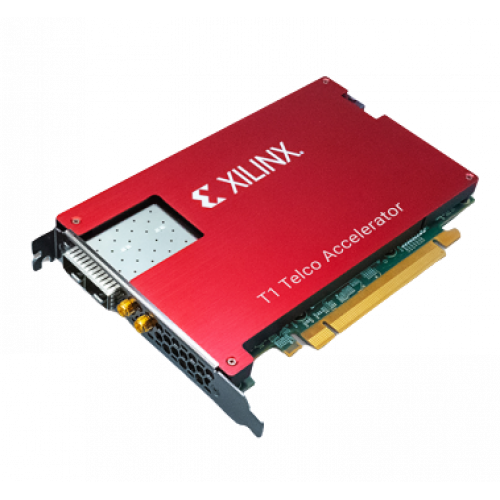Xilinx T1 Telco Accelerator Card
Industry’s 1st Telco Convergence NIC with O-RAN Fronthaul Offload and L1 Offload.
Overview
The Xilinx T1 Telco Accelerator Card is a multi-function small form factor PCIe card that performs both O-RAN fronthaul and 5G NR layer-1 acceleration in a single slot PCIe card. Engineered for Telco Grade Reliability (NEBs), the T1 Card solution delivers 10x performance increase over software only implementation (>20x solution cost reduction). T1 Card is built around Xilinx Zynq Ultrascale + MPSoC & RFSoc. The T1 Card has two 25G SFP28 and x16 PCIe interfaces bifurcated into two x8 interfaces. This Board is dual slot FHHL (full-height, half-length) form factor. 100G CMAC interface is provided between ZU21DR and ZU19EG for data transfer operations.
Key Features
- Xilinx ZU21DR RFSoC for 5G baseband processing offload
- Xilinx MPSOC ZU19EG for 5G O-RAN fronthaul termination
- x64 bit 4GB DDR4 Memory interfaced to PL
- x32 bit 2GB DDR4 Memory interfaced to PS
- Two SFP28 cages for 25G
- x16 PCIe interface bifurcated to two x8 interfaces to the host device through PCIe edge finger connector
- x16 standard NIC card form factor ( 112mm x 168mm )
- JTAG Connectors for Debugging
Reference Design on T1
- VVDN's L1 offload design with BBDEV standard APIs, which can easily interface with compliant 5G L1 software stack.
- VVDN's O-RAN split option 7-2x fronthaul design with 2x25G Ethernet/eCPRI interface with DPDK standard APIs for interfacing with compliant 5G L1 software stack.
- DU/CU
- 5G/LTE Base stations
- Data Center Acceleration
- Finance
- Networking
- Security
| Specifications | |||||||||||
|---|---|---|---|---|---|---|---|---|---|---|---|
| Dimensions | The card is compliant with the PCIe CEM 3.0 specification as a dual-slot, low profile PCIe add-in card.
|
||||||||||
| PCIe Connector/Data-Rates |
|
||||||||||
| DDR4 Specifications |
DDR4 RAM configuration
|
||||||||||
| Network Interfaces | Having two 25G SFP28 and x16 PCIe interfaces bifurcated to two x8 interfaces. | ||||||||||
| USB Maintenance Port | The ADYA card includes a covered micro-USB maintenance port at the I/O bracket. | ||||||||||
| Operating System Compatibility |
The following operating systems are supported:
|
||||||||||
| Operating and Storage Temperature Conditions |
|
VVDN IPs on T1
VVDN's Fronthaul ORAN 7-2x design is available with DPDK APIs framework for interfacing with 5G L1 stack based on 5G ORAN fronthaul interface
- U/C – plane message are fully handled in RTL
- IQ Compression and De compression : BFP and MC
- IQ bit width support from 9 bit to 16 bits
- C/U -plane Tx and Rx window Management
- S-Plane : Time stamp insertion and Extraction in RTL
- Can achieve Class C Performance
- IEEE1588 and SyncE Support
- Software support for M-plane traffic
- DPDK Based API for Transferring IQ sampled to and from Host
- Easley scalable Architecture to support multiple front haul interfaces
- Priority Based on massage Type
- Support for 10G,25G interfaces
VVDN's L1 Offload design is available with BBDev APIs, which can be easily interfaced with baseband (L1) software stack
- DPDK baseband device library framework to provide workloads for offload.
- Poll mode driver based on Xilinx QDMA to submit data to HW accelerator.
- One core is available for LDPC encode operation and three for decode operation.
- BBDev API for LDPC, rate matching hardware acceleration.
- User can submit the CB payload to the BBDEV driver after the CRC attachment.
- The BBDEV driver will fill the corresponding descriptor ring, and hardware accelerator will submit the encode/decoded data in the dequeue ring after the respective operation.

